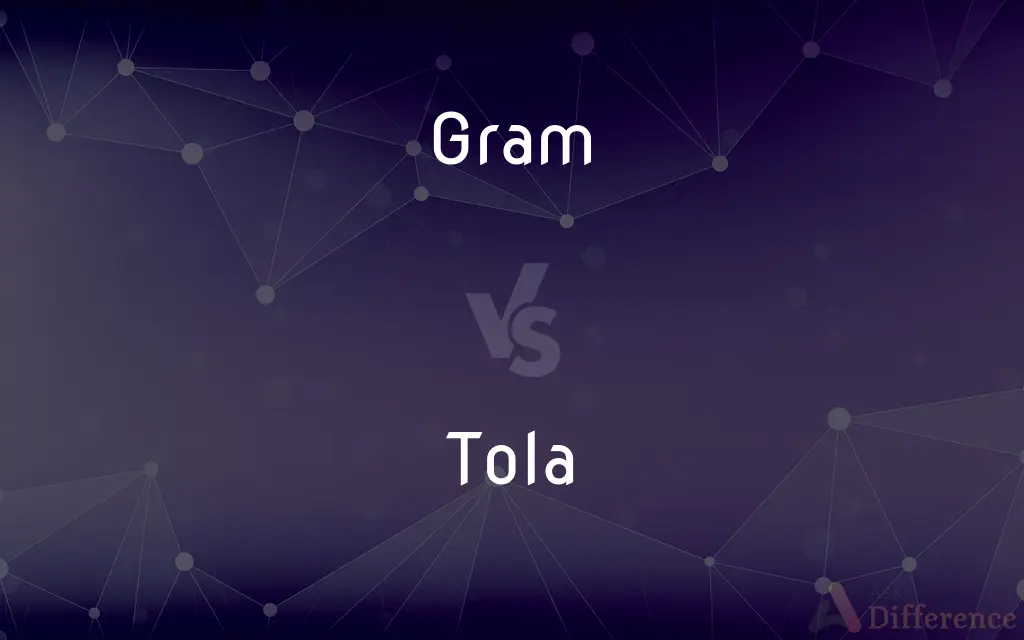Gram vs. Tola — What's the Difference?
By Maham Liaqat & Fiza Rafique — Updated on March 19, 2024
A gram is a unit of mass in the metric system, widely used globally for various measurements, whereas a tola is a traditional South Asian unit of mass, primarily used for precious metals like gold and silver.

Difference Between Gram and Tola
Table of Contents
ADVERTISEMENT
Key Differences
The gram is part of the International System of Units (SI) and is defined as one-thousandth of a kilogram, the SI base unit of mass. On the other hand, the tola is a unit of mass that originated in the Indian subcontinent and is traditionally used to measure the weight of precious metals, particularly in jewelry.
Grams serve as a standard measurement in cooking, nutrition, and package labeling, offering a precise and widely understood metric for quantities. The use of grams facilitates international trade and scientific communication due to its universal acceptance and standardization. Tolas, while not widely recognized in international or scientific contexts, play a crucial role in the cultural and economic activities of South Asia, especially in the trade of gold and silver. The value of jewelry, investments, and gifts in these regions is often quantified in tolas, embedding the unit deeply in tradition and commerce.
The transition from tolas to grams in global contexts highlights the move towards standardization and uniformity in measurements. However, the persistence of the tola in certain areas underscores the importance of cultural practices and regional preferences in commerce, especially in the precious metals market. The gram's versatility and acceptance across various fields contrast with the tola's specialized use in the jewelry and metals industry in South Asia.
Converting between grams and tolas requires understanding their specific values, with 1 tola being approximately equal to 11.66 grams. This conversion is essential in international trade and for consumers in South Asia purchasing gold or silver, where both units might be referenced. Despite the dominance of the metric system, the continued use of the tola illustrates the coexistence of global standards with local traditions.
The choice between using grams or tolas depends on the context, with grams preferred for scientific accuracy and universal understanding, while tolas are favored in traditional markets and practices related to precious metals in South Asia. This distinction reflects broader themes of globalization versus cultural heritage, demonstrating how units of measurement can signify more than just weight—they can also convey history, tradition, and identity.
ADVERTISEMENT
Comparison Chart
System
Metric system (International System of Units, SI)
Traditional South Asian unit
Definition
One-thousandth of a kilogram
Approximately 11.66 grams
Use
Universal in science, commerce, and daily life
Primarily for precious metals in South Asia
Importance
Facilitates international trade and scientific research
Embedded in cultural and economic practices
Conversion
Standard unit, no conversion needed within SI
1 tola ≈ 11.66 grams
Regionality
Global
South Asia
Application in Trade
Widely accepted in all forms of goods and services
Used in the trade of gold and silver
Compare with Definitions
Gram
Common in scientific research for its accuracy.
The laboratory tests were conducted with samples weighing exactly 5 grams each.
Tola
A traditional South Asian unit of mass, especially for gold and silver.
The bride's jewelry weighs 20 tolas.
Gram
Integral in cooking and nutrition for measuring ingredients.
The recipe requires 100 grams of flour.
Tola
Equals approximately 11.66 grams, used in jewelry trade.
He purchased a 1 tola gold coin as an investment.
Gram
A metric unit of mass equal to one-thousandth of a kilogram.
The package of rice is labeled as 500 grams.
Tola
Important in the valuation of precious metals.
The price of gold is often quoted per tola in local markets.
Gram
Used globally for precise measurements in various contexts.
The chemist weighed out 20 grams of the substance for the experiment.
Tola
Reflects regional preferences in measurement.
Customers asked for the bangle's weight in tolas for clarity.
Gram
Facilitates standardization in international trade.
The export regulations specify a maximum residue limit in milligrams per gram of product.
Tola
Deeply rooted in cultural practices and ceremonies.
Gifts of gold tolas are traditional for weddings in the region.
Gram
The gram (alternative spelling: gramme; SI unit symbol: g) is a metric system unit of mass. Originally defined as "the absolute weight of a volume of pure water equal to the cube of the hundredth part of a metre [1 cm3], and at the temperature of melting ice" (later at 4 °C, the temperature of maximum density of water).
Tola
A unit of weight used in India, equal to the weight of one silver rupee (11.7 grams or 180 troy grains).
Gram
A metric unit of mass equal to one thousandth (10-3) of a kilogram. See Table at measurement.
Tola
A unit of mass used in India, equal to the mass of a silver rupee coin, fixed at 180 troy grains ({{11.663 8038 grams}}) in 1833, and of a similar but slightly variable value before that date.
Gram
Any of several legumes, such as the chickpea, bearing seeds used as food.
Tola
A weight of British India. The standard tola is equal to 180 grains.
Gram
The seeds of such a plant.
Gram
A grandmother.
Gram
A unit of mass equal to one-thousandth of a kilogram. Symbol: g.
Gram
A leguminous plant grown for its seeds, especially the chickpea.
Gram
(uncountable) The seeds of these plants.
Gram
Grandmother.
Gram
(US) graham
Gram
(colloquial) 'gram
Gram
Angry.
Gram
The East Indian name of the chick-pea (Cicer arietinum) and its seeds; also, other similar seeds there used for food.
Gram
A metric unit of weight equal to one thousandth of a kilogram
Gram
Danish physician and bacteriologist who developed a method of staining bacteria to distinguish among them (1853-1938)
Common Curiosities
Why is the tola important in South Asia?
The tola is embedded in the cultural and economic practices of South Asia, especially in the trade of gold and silver, reflecting its significance in tradition and commerce.
What is the difference between a gram and a tola?
The gram is a universal metric unit of mass, while the tola is a traditional South Asian unit primarily used for precious metals, with 1 tola equaling approximately 11.66 grams.
How are grams used in daily life?
Grams are used globally for measuring everything from food ingredients and package contents to scientific samples, facilitating precision and standardization.
Can the gram and tola be used interchangeably?
While conversion is possible (1 tola ≈ 11.66 grams), their use depends on context, with grams preferred for scientific and general purposes, and tolas used in South Asian precious metals markets.
How do you convert grams to tolas and vice versa?
To convert grams to tolas, divide the number of grams by 11.66. To convert tolas to grams, multiply the number of tolas by 11.66.
Are there any other units similar to the tola in other cultures?
Many cultures have traditional units for measuring precious metals and other goods, but the tola is specifically significant in South Asia for its historical and cultural relevance.
Is the tola recognized internationally?
The tola is primarily recognized in South Asia and by those involved in the international trade of precious metals from the region, but it is not a standard unit in the metric system.
What makes the gram a preferred unit of measurement globally?
The gram's preference stems from its inclusion in the International System of Units (SI), facilitating universal understanding, precision in measurements, and ease of international trade.
Why do some regions still use the tola?
The continued use of the tola in certain regions reflects the enduring influence of cultural traditions and regional preferences, especially in the context of jewelry and precious metals.
Has the use of the tola changed over time?
While the metric system has become more dominant globally, the tola continues to be used in South Asia for precious metals, maintaining its cultural and commercial importance despite the trend towards standardization.
Share Your Discovery

Previous Comparison
Badger vs. Raccoon
Next Comparison
Lithectomy vs. LithotomyAuthor Spotlight
Written by
Maham LiaqatCo-written by
Fiza RafiqueFiza Rafique is a skilled content writer at AskDifference.com, where she meticulously refines and enhances written pieces. Drawing from her vast editorial expertise, Fiza ensures clarity, accuracy, and precision in every article. Passionate about language, she continually seeks to elevate the quality of content for readers worldwide.














































